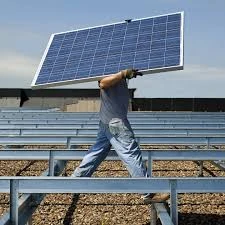Understanding the Size of a 1000 Watt Solar Panel System for Your Needs
Understanding the Size of a 1000W Solar Panel System
As the world increasingly turns to renewable energy sources, solar panels have gained immense popularity as a means for homeowners and businesses to harness solar energy. Among the various solar power systems available, a 1000W (or 1 kW) solar panel system is a common choice for those looking to reduce their electricity bills and lower their carbon footprint. But how large is a 1000W solar panel system, and what factors should you consider when installing one?
What Size Can You Expect?
The size of a 1000W solar panel system largely depends on the efficiency of the solar panels you choose. On average, typical solar panels produce between 250W and 400W of power per panel. Assuming you’re using 300W panels, you would need around four panels to achieve a total output of 1000W. In terms of dimensions, modern solar panels typically measure about 65 inches by 39 inches (approximately 1.65 meters by 1 meter). Therefore, a system capable of producing 1000W would require around 65 square feet (about 6 square meters) of roof space or ground area.
However, it’s worth noting that the physical size may vary based on panel efficiency; higher efficiency panels produce more power per square foot, which could reduce the number of panels required. Furthermore, the output of solar panels is also influenced by factors such as sunlight exposure, the angle of installation, and geographic location.
Important Considerations for Installation
1. Space Availability Before purchasing panels, assess the roof space available for installation. Ensure that the area is free from obstructions like chimneys, trees, or other buildings that could potentially cast shadows on the panels.
1000w solar panel size

2. Orientation and Tilt The orientation of your solar panels plays a crucial role in energy production. Ideally, panels should face south in the Northern Hemisphere for maximized sunlight exposure. Additionally, the angle or tilt of the panels can impact performance; consider local climate conditions to determine the best angle.
3. Local Regulations Every region has its own regulations regarding solar panel installations. Before proceeding, check with local authorities about permits, zoning laws, and any incentives or rebates available for solar installations.
4. Potential Energy Output Evaluate your energy needs to determine if a 1000W solar panel system is adequate for your consumption. Calculate your average electricity usage from your utility bills to ensure that this system can meet your energy requirements.
5. Costs and Financing While solar panels have become more affordable, investing in a solar system involves upfront costs. Explore financing options such as solar loans, leases, or power purchase agreements (PPAs) that can help make your solar investment more manageable.
Conclusion
Installing a 1000W solar panel system can be a fantastic step toward embracing renewable energy, reducing utility bills, and contributing to environmental sustainability. By understanding the size and factors influencing the installation of such a system, you can better prepare for a successful transition to solar energy. As technology continues to evolve, the efficiency and affordability of solar panels will likely improve, making clean energy even more accessible to everyone.
-
Understanding the Advantages of Solar String Inverters for Your Energy SystemNewsApr.29,2025
-
Choosing the Right PV Inverter: A Comprehensive GuideNewsApr.29,2025
-
The Future of Solar Power: Exploring Bifacial Solar PanelsNewsApr.29,2025
-
The Complete Guide to Solar Panels: Efficiency, Cost, And InstallationNewsApr.29,2025
-
The Best Options for Efficiency and Cost-EffectivenessNewsApr.29,2025
-
Harnessing the Power of Off-Grid Solar Inverters for Energy IndependenceNewsApr.29,2025







